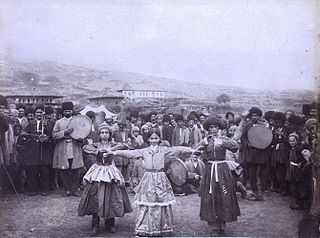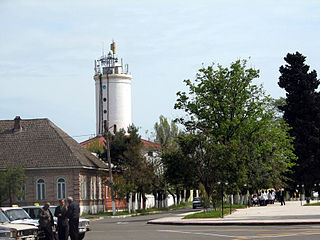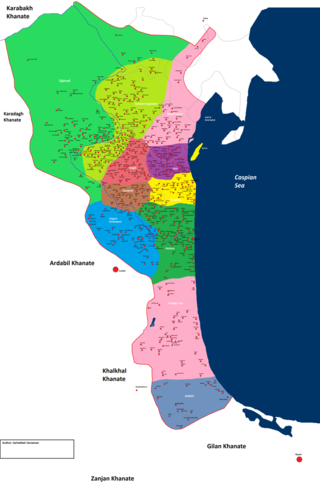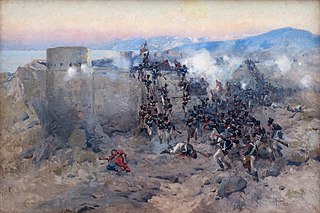Related Research Articles

Fath-Ali Shah Qajar was the second Shah (king) of Qajar Iran. He reigned from 17 June 1797 until his death on 24 October 1834. His reign saw the irrevocable ceding of Iran's northern territories in the Caucasus, comprising what is nowadays Georgia, Dagestan, Azerbaijan, and Armenia, to the Russian Empire following the Russo-Persian Wars of 1804–1813 and 1826–1828 and the resulting treaties of Gulistan and Turkmenchay. Historian Joseph M. Upton says that he "is famous among Iranians for three things: his exceptionally long beard, his wasp-like waist, and his progeny."

The Talysh people are an Iranian ethnic group indigenous to the Talish region shared between Azerbaijan and Iran which spans the South Caucasus and the southwestern shore of the Caspian Sea. They speak the Talysh language, one of the Northwestern Iranian languages. It is spoken in the northern regions of the Iranian provinces of Gilan and Ardabil and the southern parts of the Republic of Azerbaijan. The areas in the Republic of Azerbaijan where Northern Talysh is spoken was historically known as Talish-i Gushtasbi. In Iran there is a Talesh County in Gilan Province.

The Karabakh Khanate was a khanate under Iranian and later Russian suzerainty, which controlled the historical region of Karabakh, now divided between modern-day Armenia and Azerbaijan. In terms of structure, the Karabakh Khanate was a miniature version of Iranian kingship. The administrative and literary language in Karabakh until the end of the 19th century was Persian, with Arabic being used only for religious studies, despite the fact that most of the Muslims in the region spoke a Turkic dialect.


Molla Panah, better known by his pen-name Vagif, was an 18th-century Azerbaijani poet, statesman and diplomat. He is regarded as the founder of the realism genre in Azerbaijani poetry. He served as the vizier—the minister of foreign affairs—of the Karabakh Khanate during the reign of Ibrahim Khalil Khan.

The Khanate of Kalat was a Brahui Khanate that originated from the Kalat region of Pakistan. Formed in 1666 due to the threat of Mughal expansion in the region, it controlled the wider Balochistan at its greatest extent in the mid-18th century, extending from Kerman in the west to Sindh in the east and from Helmand river in the north to the Arabian sea in the south. Khanate of Kalat lost considerable area to Qajar Iran and Emirate of Afghanistan in the early 19th century, and the city of Kalat was itself sacked by the British in 1839. Kalat became a self-governing state in a subsidiary alliance with British Raj after the signature of the Treaty of Kalat by the Khan of Kalat and the Baloch Sardars in 1875, and the supervision of Kalat became task of the Baluchistan Agency. Kalat was briefly independent from 12 August 1947 until 27 March 1948, when its ruler Ahmad Yar Khan acceded to Pakistan, making it one of the Princely states of Pakistan.

The Baku Khanate, was a khanate under Iranian suzerainty, which controlled the city of Baku and its surroundings from 1747 to 1806.

Talysh Khanate or Talish Khanate was a khanate of Iranian origin that was established in Persia and existed from the middle of the 18th century till the beginning of the 19th century, located in the south-west coast of the Caspian Sea.

The Ganja Khanate was a khanate under Iranian suzerainty, which controlled the town of Ganja and its surroundings, now located in present-day Azerbaijan.

Shirvan Khanate was a Caucasian khanate under Iranian suzerainty, which controlled the Shirvan region from 1761 to 1820.

The Nakhichevan Khanate was a khanate under Iranian suzerainty, which controlled the city of Nakhichevan and its surroundings from 1747 to 1828.

The Erivan Khanate, also known as Chokhur-e Sa'd, was a khanate that was established in Afsharid Iran in the 18th century. It covered an area of roughly 19,500 km2, and corresponded to most of present-day central Armenia, the Iğdır Province and the Kars Province's Kağızman district in present-day Turkey and the Sharur and Sadarak districts of the Nakhchivan Autonomous Republic of present-day Azerbaijan.

The siege of Lankaran took place from 7 January to 13 January 1813 during the Russo-Iranian War of 1804–1813. Lankaran, a city in the Talish region, was previously held by Mir-Mostafa Khan of the Talysh Khanate, a subject of Iran. However, due to his defiance, he was ousted from the city by Iranian forces in August 1812. Now directly held by the Iranians, the city was soon besieged by the Russian commander Pyotr Kotlyarevsky, who had recently defeated the Iranian crown-prince Abbas Mirza at the battle of Aslanduz.

After Nader Shah was assassinated in 1747, his nephew Ali Qoli seized the throne and proclaimed himself Adil Shah. He ordered the execution of all Nader's sons and grandsons, with the exception of the 13-year-old Shahrokh, the son of Reza Qoli.
Hedayat-Allah Khan was a Gilaki prince, who was the semi-independent ruler of Gilan from 1753 to 1786.
Mostafa Khan was the last khan of Shirvan, until 1820.
Jamal al-Din Khan was the first khan of the Talysh Khanate under Iranian suzerainty, ruling from 1747 to 1786.

The region of Talish was a governorate of Safavid Iran (1501–1736), located in the greater Talish, presntly divided between Iran and Azerbaijan. The territory of the governorate was principally made up of the two subordinate governorates of Astara and Lankaran. The city of Astara was its administrative center, the base of Safavid power in the region.
Mir-Hasan Khan was the last khan of the Talysh Khanate from 1813 to 1829. He was the son and successor of Mir-Mostafa Khan.
The Akhbar-nameh is a Persian-language chronicle on the history of Talish. It was composed by Mirza Ahmad ibn Mirza Khodaverdi, the vizier of the two last khans of the Talysh Khanate.
References
- ↑ Shahvar & Abramoff 2018, p. 29.
- ↑ Shahvar & Abramoff 2018, p. 39.